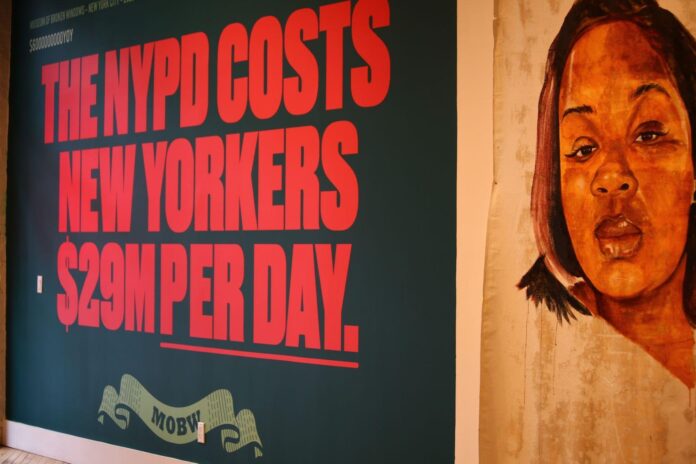An inconspicuous storefront in Manhattan’s popular Nolita neighbourhood now houses the Museum of Broken Windows, a pop-up space whose main exhibition asks: how else could New Yorkers spend the $29m per day that the municipal government spends on the New York Police Department (NYPD)?
The show, 29 Million Dreams (until 6 May), transforms the figure into a conceptual opportunity, showcasing the resilience of community while emphasing the human cost of over-policing in New York, which has the largest police force in the country. The run of the exhibition coincides with New York City mayor Eric Adams’s adoption of the city’s latest budget, expected to maintain the NYPD’s funding at $11bn while slashing budgets for social services that were already underfunded.
“Eleven billion is not a number that makes sense to anyone that’s not a billionaire,” says Johanna Miller, director of the Education Policy Center at the New York Civil Liberties Union (NYCLU). “But we can understand $29m dollars a day. With what the police spend just to cover their overtime this year, we could have kept libraries in the city open six days a week.”
The Museum of Broken Windows is a collaboration between the NYCLU and Soze, a creative strategy agency. Its inaugural exhibition in 2018 featured 60 works that were critical of the NYPD’s “stop-and-frisk” practice, which came under fire after data showed that 90% of those detained were Black or Latinx. The present iteration takes its name from the “broken windows” theory, coined in 1982 by social scientists James Q. Wilson and George L. Kelling, which holds that visible signs of “anti-social behaviour” create environments that encourage crime. The theory heavily influenced New York mayor Rudy Giuliani’s approach to law enforcement in the 1990s.
29 Million Dreams traces the legacy of the “broken windows” strategy in the killings of Black and brown civilians by police across the country, an epidemic that inspired global racial justice protests in the summer of 2020. Despite a timely swell of abolitionist sentiment during the height of Covid-19 lockdowns, the Adams administration has relied heavily on the NYPD to address all manner of ills.
“We can’t ask or expect the NYPD to be the answer to everything from the lack of affordable housing or the dire shortage of mental health care, to even school discipline,” says Donna Lieberman, NYCLU’s executive director. “As the mayor and [city] council negotiate the city budget, they should break away from police-first problem solving, visit the Museum of Broken Windows and make our dreams reality.”
The exhibition is co-curated by Daveen Trentman of the Soze Agency and Terrick Gutierrez, an interdisciplinary artist based in Los Angeles. It highlights a wide range of work by more than 20 artists, many of whom have experienced the toll of over-policing firsthand.
Artist Russell Craig, whose portrait of Louisville police victim Breonna Taylor hangs solemnly on the first floor of the exhibition, is a formerly incarcerated artist and co-founder of Right of Return, USA, the first national fellowship dedicated to supporting artist survivors of the prison industrial complex. “We all know the story of Breonna Taylor, so I thought I would make pieces like this to act as reminders,” Craig says. “It happens so much, we get conditioned.”
Marcus Manganni, a former Right to Return fellow, has also contributed his 2022 piece, End to End Burners, to the show. An opulent chandelier made from 1,500 hand-made shivs, it serves as a meditation on his time in solitary confinement on Rikers Island, New York City’s infamous jail complex—which is scheduled to close in 2027. “I was thinking about carceral architecture, just bodies upon bodies upon bodies,” Manganni says. “It’s about confronting the trauma of space.”
Works on display range from humanising, quiet photographs of New York City sex workers by Kisha Bari to a plaintive collection of paintings depicting mothers holding pictures of their murdered children by Tracy Hertzel. “Policy paired with art can really inform the cultural zeitgeist,” Trentmen says. “It makes the message simple, plain, and boils it down to human impact and experience.”
A series of free events will take place throughout the run of the exhibition, from spoken word slams to activist panels. According to Miller, the project’s objective “combines policy advocacy, visual arts and performance art” to create a holistic rumination on social injustice for viewers.
Gutierrez adds, “Love is really central to this exhibition, even in its heaviness.”
- 29 Million Dreams, until 6 May, Museum of Broken Windows, New York

























